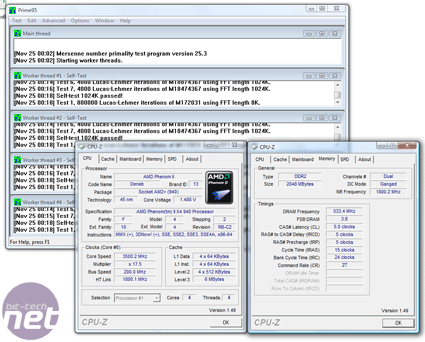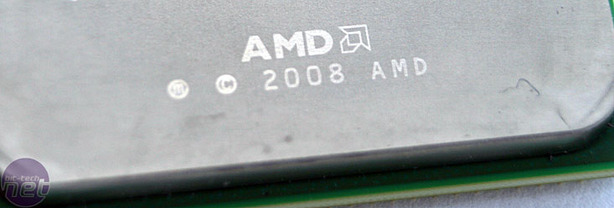
Overclocking

As our faithful Asus M3A79-T died just before the festive period we were left having to use the AMD provided MSI 790GX for this review as it was the only other one we have with a Phenom II BIOS at this time. Unfortunately, its BIOS is pretty weak and it's not a great overclocker.
After a little play and some frustration we managed to get 3.7GHz out of it at 1.488V, but it didn't last long, and we eventually settled for 3.5GHz through multiplier overclocking only (17.5x) with a -2 percent ACC correction on all cores at the same voltage. At this, we found it was fully stable and would Prime95 without fault.
We tried again with a bit more voltage, this time 1.512V, which is a lot for a 45nm CPU and 1.30V on the CPU Uncore even though we had left this at stock speeds. At this it would last five minutes before blue screening while burning in with Prime95. We did manage to squeeze a failed 4GHz overclock out of it, but it would only POST and not load the OS.
We think a better board would certainly yield better results for this CPU and Phenom IIs are certainly an improvement over the original Phenoms, but comparing to Intel's 45nm CPUs - especially Nehalem - the Intel chips are still more overclockable for the average enthusiast at lower voltages, without needing to resort to extremes like water, phase or LN2.
We'll certainly come back to Phenom II overclocking in the near future once we have more time to play (and not just benchmark!) on better boards (like the DFI 790FX LANParty for example) - at that point, we'll have a better idea of what's going on. For now though, it seems that AMD's promises of 4GHz are a little far fetched, but 3.5 to 3.7GHz should be do-able, unless there are some major BIOS breakthroughs in the coming weeks or the AM3 CPUs fare better.
Performance Conclusions
We have to say we're very impressed, but mostly because of the very competitive price AMD has hit. Without knowing this during testing we have to say we were more reluctant as a 3.0GHz Phenom II X4 was hitting 2.67 - 2.83GHz Core 2 Quad, meaning the Intel Core 2 CPUs are more efficient in a direct clock to clock comparison.We're not even comparing the Phenom IIs to Core i7s simply because Intel's latest architecture is not only leagues ahead, the barriers to entry are massive: motherboards cost up to twice as much and memory can cost three or four times more, so even a $284 Core i7 920 platform is much greater investment.
In a clock to clock advancement, the Phenom IIs are a pretty solid four or five percent faster than the original Phenoms throughout many of our tests and it's mostly the greater core clock that has won favour for the AMD CPUs. After all these benchmarks, despite complaining about the initial memory performance drop, we understand why AMD decided to drop the clocks back a bit - given the available thermal overhead it was better to have faster core clocks.
Intel will still win the day in terms of absolute performance, but this always comes at a price and in the mainstream and performance-value market AMD is very competitive and enthusiasts should be interested in its CPUs once again, especially if you already have an AM2+ motherboard and want a swift upgrade.
Unfortunately, the downside is that the 940 and 920 will be the only AM2+ CPUs, with the AM3s arriving shortly these newer CPUs will have both DDR3 and DDR2 memory controllers making them compatible with AM2+ and AM3 boards, but the current AM2+ CPUs won't fit in AM3 boards (no DDR3 controller). Like the original Phenoms though, the 940 and 920 will fit in older AM2 boards, but will obviously lack HT3.0 and advanced power saving feature support.
We've got no firm details about the cost of AM3 processors right now, but we expect the motherboards and CPUs to be a little more expensive. What's more, if you've already invested in DDR2 then these Phenom II X4s on AM2+ look like a good option. Where AMD is going to be lacking is in the server market though: to really compete with Intel though AMD needs some hefty IPC increases, and we fear this won't arrive until the end of next year, possibly even into 2011, so how will AMD remain competitive in the long term?

Final Thoughts
The bottom line is that unless Intel drops its price to win favour on the Q9550 and Q9450/Q9400, like it did with the Q6600 when the original Phenom X4s launched, AMD's CPUs will be good value. The Q6600 at £160 will undercut them and still do 3.0-3.6GHz, however the Phenom II X4 at 3.5-3.7GHz will make it faster still and effectively price competitive.We'd obviously still love to see a cut down £100, or even £150 Phenom II X4 do a large overclock on air: that would be awesome, but for now ~£200-£250 still isn't a huge ask for a competitive CPU that doesn't use a whole lot of power (until overclocked and heavily overvolted). While not the best performer we've ever seen, AMD has finally got a solid competitor it can sell on an inexpensive platform - this should readdress the balance quite nicely in the market.
Phenom II X4 940
- Performance
- x
- x
- x
- x
- x
- x
- x
- x
- -
- -
- 8/10
- Value
- x
- x
- x
- x
- x
- x
- x
- -
- -
- -
- 7/10
- Overall
- x
- x
- x
- x
- x
- x
- x
- x
- -
- -
- 8/10
Phenom II X4 920
- Performance
- x
- x
- x
- x
- x
- x
- x
- x
- -
- -
- 8/10
- Value
- x
- x
- x
- x
- x
- x
- x
- -
- -
- -
- 7/10
- Overall
- x
- x
- x
- x
- x
- x
- x
- x
- -
- -
- 8/10

MSI MPG Velox 100R Chassis Review
October 14 2021 | 15:04








Want to comment? Please log in.